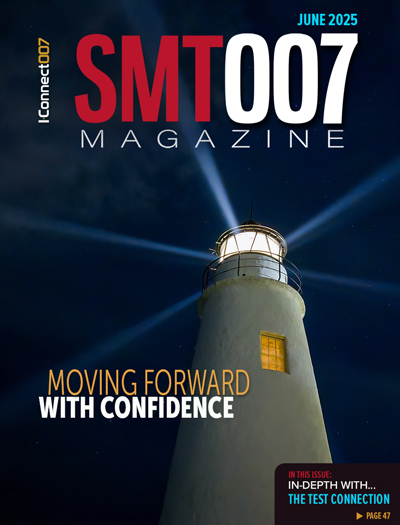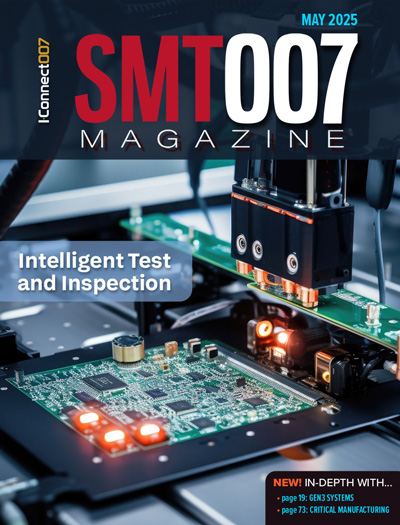-

-
News
News Highlights
- Books
Featured Books
- smt007 Magazine
Latest Issues
Current Issue
What's Your Sweet Spot?
Are you in a niche that’s growing or shrinking? Is it time to reassess and refocus? We spotlight companies thriving by redefining or reinforcing their niche. What are their insights?

Moving Forward With Confidence
In this issue, we focus on sales and quoting, workforce training, new IPC leadership in the U.S. and Canada, the effects of tariffs, CFX standards, and much more—all designed to provide perspective as you move through the cloud bank of today's shifting economic market.

Intelligent Test and Inspection
Are you ready to explore the cutting-edge advancements shaping the electronics manufacturing industry? The May 2025 issue of SMT007 Magazine is packed with insights, innovations, and expert perspectives that you won’t want to miss.
- Articles
- Columns
- Links
- Media kit
||| MENU - smt007 Magazine
Ionics EMS Talks Industry 4.0, Mil/Aero Opportunities, and Supply Chain
September 26, 2016 | Stephen Las Marias, I-Connect007Estimated reading time: 8 minutes
Philippine-based Ionics EMS Inc. is the first locally owned electronics manufacturing services (EMS) company in the Philippines. Founded by Larry Qua, currently the chairman and CEO of Ionics EMS and Ionics Group of Companies, the company has been around for 42 years. It started with semiconductor manufacturing services, and transitioned to EMS after less than eight years.
In an interview with SMT Magazine, Dr. Jay Sabido, president and COO of Ionics EMS Inc., discusses a wide range of topics, including Industry 4.0, automation, the challenges in electronics manufacturing, and the Philippine landscape. We also examine the challenges in the military and aerospace industry, including lead-free, counterfeit components, and traceability.
Stephen Las Marias: For anyone who’s not familiar with your company, please give us a quick background.
Dr. Jay Sabido: Aside from being the first local SMS—and then EMS—company in the country, there’s actually a series of firsts for Ionics. From the first PCBAs to large-area LCDs when it still wasn’t fashionable to have laptop or tablets, Ionics has been actually producing them already way back since 1982. We are also the first EMS company to be listed in the Philippine Stock Exchange, and be dual-listed in the Singapore Stock Exchange.
In a nutshell, that’s really what Ionics is all about. It’s a full, end-to-end EMS company; we offer everything from design services, to NPI, and even prototyping. Design services cover industrial design, electronic design, and embedded software. We provide complete traditional electronics manufacturing services, drop-shipping and delivery. We deliver to 162 countries and counting.
Las Marias: What is your company’s “sweet spot”?
Dr. Sabido: We’re really big on advanced manufacturing technologies. That’s what makes us stand out from the other EMS companies. From this, it branches out into some of the things we are actually doing, such as medical electronics and telecoms, which really can be quite challenging in terms of testing and handling. We really require a lot of innovation and manufacturing technology development. That continues to be the sweet spot for Ionics, even moving forward right now.
Las Marias: What sort of challenges are your customers facing?
Dr. Sabido: Globally, we all feel these. First, time-to-market is becoming shorter and shorter. And because of fierce competition globally—because there are too many players—cost is an issue. Time-to-market is very important, and of course, once again, cost.
We feel it now more than ever. But people demand more and more. For the past several years now, consumer expectations are more advanced than what companies can produce. And companies are trying to keep up with what people are expecting. Now you can actually hear the average person saying she wants this and that, and then big name companies will be saying it will take them a while to develop something like this. Before, it was just in the realm of science fiction authors. But now, anybody can dream of what they want their devices to be.
I remember when I was in grad school back in the early 90s, we were just talking about personal communication systems. Now, everybody knows what it’s all about. It’s very hard to imagine before that a phone or number in every hand—your unique identifier.
Going back to your question, I think it’s really that the electronics being very pervasive—from something very small, such as implants to the body, all the way to something fairly big—and the challenge of that is becoming more and more difficult; and there’s a lot of expectations from the public in terms of when they want it, how they want it. It’s a chance for manufacturers because instead of having a high-volume, low-mix line, right now it’s really low-volume, high-mix. There are too many variations; ideally, it is a market of one. And that’s one of the challenges again: how to deliver that, in the same cost or even cheaper.
Las Marias: What forces do you see driving the industry?
Dr. Sabido: People are talking a lot now about Industry 4.0, where manufacturing is really shifting. It’s the marriage of operational technologies (OT) and information technologies (IT). It’s an enabler, and at the same time, more of a need already because it will enable us to address those challenges such as time-to-market, cost—the usual things that manufacturers face. What’s shaping that, and what allows us to be able to do that is the vision of Industry 4.0. And I see more and more automation—such as robotics—in the factory floor. The use of IT, not just to do reporting but really to do more advanced stuff. It’s really the guiding force in the industry right now, and it’s really what’s enabling us to go to the next level.
Las Marias: How do companies justify investments in such advanced technologies?
Dr. Sabido: There are actually two ways of looking at it. The obvious one is that it really should make business sense. The biggest justification is that it really should make manufacturing more effective and result in cost savings. This is what we’ve seen in some of the things we’re doing in our journey towards Industry 4.0, and I think we are leading the pack. We made an announcement last year about our tie-up with IBM and Apple for a smart factory.
The way we justify it is that it would make us more cost effective; granted it cannot be applied to a lot of different lines. And I think that’s where the secret is—although it’s not that secret. There are certain lines where it’s applicable, for instance, SMT equipment really screams for automation; for IT to actually help; and to increase your OEE, to name a few.
The way you monitor your scrap—that’s fairly straight forward. And that will already result in cost savings. That in itself justifies the investments we are putting in the front end, the front line, which is the SMT area. The back-end is the one that’s more challenging because that’s where a lot of variations come in, which require a lot more creative ways of going about it. Probably, not all the lines will have that, but there are lines that justify that. For lines that really require you to have very consistent quality, very tight tolerances, I think that’s where it can become effective.
For things like in automotive, wherein you really have to tightly control it, and in something where robots can actually help you, can achieve very tight tolerances; I think that’s where the investments make sense. Where you actually need to produce something at very high speed, and really run operations 24/7 minimizing the downtime and changeover time, that’s where robotics can get you more out of your machine and your line. That’s where Industry 4.0 makes sense. And everybody is actually looking at it, including low-cost-labor countries because there are some lines or some products where that makes sense.
Las Marias: What challenges and opportunities do you see for your company in the upcoming year?
Dr. Sabido: I think the most obvious is really executing our roadmap for Industry 4.0. That is something that’s very important. The other one is something that the industry as a whole is facing, and it’s not only for EMS companies, but every company in general: talent. At the last SEIPI show, I gave a talk on the strategies and the challenges that companies are facing right now. And my basis was the 2016 Deloitte study on global manufacturing competitiveness. They interviewed more than 500 senior executives of manufacturing companies—they do it every three years—and the number one challenge for the past six years has been talent: getting skilled people and hiring great engineers. In spite of talking about automation and the need for other advanced manufacturing technologies, they really need great people. And that’s what can make or break a company. Not only in the Philippines, but globally; the manufacturing industry is experiencing the same thing.
The number one pain point and challenge will always be people. Where to get good people, how to get good people, because it’s a very fierce competition right now globally for good talent. The Philippines has been experiencing that, other ASEAN countries, outside ASEAN as well, and even China and North America and Europe: it’s retaining talent, acquiring them, training them, and really growing them. You really have to take care of your people, to make sure that they continue to be motivated and excited with the work that they do.
The second one is circling back to what I mentioned: advances in manufacturing technologies are really there for the picking, and therefore execution and implementation become a challenge. They are not cheap, so it really requires good business justification for it to be created, where it can really be impactful, in your line. It doesn’t have to be end-to-end, but where it makes sense, applying the technology where it makes sense and where it can really justify the business.
Those are the two greatest challenges. The third is really competition. For an EMS company, how would you differentiate yourself from others is really a big thing, and usually it has always been about cost, proximity, and relationship. And it may have worked in the past—and of course it still continues to be a traditional business—but now, we cannot be complacent, and we have to be able to differentiate ourselves and continue to really grow our business.
To read this entire article, which appeared in the September 2016 issue of SMT Magazine, click here.
Suggested Items
TT Electronics Secures Multi-Million-Pound Defense Contract with Ultra PCS
07/18/2025 | TT ElectronicsTT Electronics, a leading provider of global manufacturing solutions and engineered technologies, announced that it has been awarded a significant new contract with long-standing customer Ultra PCS Ltd (Ultra Precision Control Systems).
NEOTech’s Agave 1 Facility Earns AS9100 Certification for Commercial Aerospace Manufacturing Excellence
07/17/2025 | NEOTechNEOTech, a premier provider of electronic manufacturing services (EMS), integrated design engineering, and advanced supply chain solutions for the aerospace and defense, medical device, and high-tech industrial markets, proudly announces that its Agave 1 manufacturing facility in Juarez, Mexico has officially received AS9100 certification.
Federal Electronics Invests in HydroJet Inline Cleaning Technology at Hermosillo Facility
07/15/2025 | Federal ElectronicsFederal Electronics, a leader in providing advanced electronic manufacturing services, has strengthened the advanced cleaning capabilities of its Hermosillo, Mexico facility with the recent installation of a HydroJet Inline Cleaner from Austin American Technology (AAT).
FTG Announces Q2 2025 Financial Results
07/09/2025 | Globe NewswireFiran Technology Group Corporation announced financial results for the second quarter 2025. Revenue: Recorded at $48.7 million, a 25.6% increase over Q2 2024.
Moog Announces Acquisition of COTSWORKS
07/07/2025 | BUSINESS WIREMoog Inc., a worldwide designer, manufacturer and systems integrator of high-performance precision motion and fluid controls and control systems, announced the acquisition of COTSWORKS Inc., an aerospace and defense fiber optics transceiver component manufacturer, for a purchase price of $63 million.


